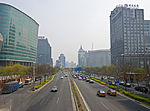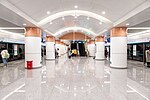Gate of Blending Harmony
Buildings and structures in BeijingChina stubsForbidden City

The Gate of Blending Harmony (Chinese: 协和门), or the Gate of Xiehe, Xiehemen, is a gate sits on the central road of the outer court of the Forbidden City, outside of the Gate of Supreme Harmony. On the eastern and opposite of the road to the Gate of Glorious Harmony. It was first built in the 18th year of Yongle and named the Gate of Left Obedience. The current one is re-built in the early years of Shunzhi and named so.
Excerpt from the Wikipedia article Gate of Blending Harmony (License: CC BY-SA 3.0, Authors, Images).Gate of Blending Harmony
QIHELOU NANXIANG, Dongcheng District Donghuamen (首都功能核心区)
Geographical coordinates (GPS) Address Nearby Places Show on map
Geographical coordinates (GPS)
| Latitude | Longitude |
|---|---|
| N 39.914527 ° | E 116.398516 ° |
Address
北京市第二十七中学
QIHELOU NANXIANG
100010 Dongcheng District, Donghuamen (首都功能核心区)
Beijing, China
Open on Google Maps










